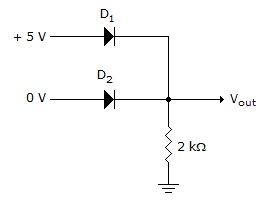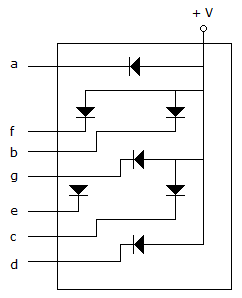Discussion
Home ‣ Digital Electronics ‣ Signals and Switches See What Others Are Saying!
- Question
Determine if diodes D1 and D2 in the given figure are forward or reverse biased.

Options- A. D1 forward and D2 reverse
- B. D2 forward and D1 reverse
- C. D1 and D2 reverse
- D. D1 and D2 forward
- Correct Answer
- D1 forward and D2 reverse
- 1. The final output of a modulus-8 counter occurs one time for every ________.
Options- A. 8 clock pulses
- B. 16 clock pulses
- C. 24 clock pulses
- D. 32 clock pulses Discuss
- 2. What is one disadvantage of an S-R flip-flop?
Options- A. It has no enable input.
- B. It has an invalid state.
- C. It has no clock input.
- D. It has only a single output. Discuss
- 3. How many flip-flops are required to produce a divide-by-128 device?
Options- A. 1
- B. 4
- C. 6
- D. 7 Discuss
- 4. I/O-mapped systems identify their input and output devices by giving them an 8-bit port number.
Options- A. True
- B. False Discuss
- 5. The modulus of a counter is the actual number of states in its sequence.
Options- A. True
- B. False Discuss
- 6. The simplified form of
 .
.
Options- A. True
- B. False Discuss
- 7. The following combination is correct for an EVEN parity data transmission system:
data = 100111100 and parity = 0
Options- A. True
- B. False Discuss
- 8. An AND gate with schematic "bubbles" on its inputs performs the same function as a(n)________ gate.
Options- A. NOT
- B. OR
- C. NOR
- D. NAND Discuss
- 9. The diagram given below shows a ________, and in order for the decimal number 3 to be displayed, terminals ________ must be ________.

Options- A. common-cathode seven-segment display, ef, LOW
- B. common-anode seven-segment display, abcdg, HIGH
- C. common-anode seven-segment display, abcdg, LOW
- D. common-cathode seven-segment display, abcdg, HIGH Discuss
- 10. The device shown in below is a ________ and for the waveforms shown in the accompanying diagram, the ________ output at point X will be ________ and all others will be ________.

Options- A. multiplexer, D4, HIGH, LOW
- B. demultiplexer, D3, LOW, HIGH
- C. demultiplexer, D3, HIGH, LOW
- D. decoder, D12, LOW, LOW Discuss
More questions
Correct Answer: 8 clock pulses
Correct Answer: It has an invalid state.
Correct Answer: 7
Correct Answer: True
Correct Answer: True
Correct Answer: True
Correct Answer: False
Correct Answer: NOR
Correct Answer: common-anode seven-segment display, abcdg, LOW
Correct Answer: demultiplexer, D3, LOW, HIGH
Comments
There are no comments.More in Digital Electronics:
Programming
Copyright ©CuriousTab. All rights reserved.
